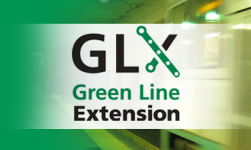 The Green Line extension will be built. It must be built. Not only because it’s a legal commitment as part of the Big Dig and Clean Air Act, but because it is a critical regional transportation project that will increase transit accessibility, reduce travel time, improve air quality, and promote significant economic development and employment.
The Green Line extension will be built. It must be built. Not only because it’s a legal commitment as part of the Big Dig and Clean Air Act, but because it is a critical regional transportation project that will increase transit accessibility, reduce travel time, improve air quality, and promote significant economic development and employment.
The benefits have been proven again and again.
- The GLX will increase access to rapid transit in Somerville from currently 15% of residents living within a half mile of a transit station to 80%. It will also serve residents/commuters of Medford and East Arlington.
- The GLX will provide transit access for a large environmental justice population in East Somerville, Union Square, Winter Hill, and around Route 16 who currently must use unreliable and often infrequent bus service. Rapid transit via a GLX station will increase access to jobs and will reduce air pollution exposure.
- City planning for housing and employment density around the planned stations is addressing the Commonwealth’s goals in promoting economic growth and housing. We cannot move backward.
The Costs
Although real costs of construction projects are increasing, this doesn’t account for the GLX $1 billion overall increase.
The GLX cost increases are mainly the result of scope changes to the project. Such changes include:
- Building the Lechmere station, which was originally to be paid for by the North Point developer
- Enhanced designs of the stations, which were originally envisioned as more simple stops
- The maintenance facility
- More complex utility work and drainage issues that were not initially known
Here’s another piece of the puzzle: Because the Construction Manager/General Contractor (CM/GC) bidding system allows only one bidder rather than competing bidders, the contractor has no incentive to keep costs down. And so the estimate climbs.
Our improved regional economic climate makes it more challenging to get competitive construction bids. This trend is industry-wide in Massachusetts and is particularly challenging in the Boston area. And so the estimate climbs.
Given all of these frustrating factors, here’s our take: The Green Line extension must be built, and we would accept further delays on the project in order for the contract to be re-bid in the hopes of bringing down costs.
Further delays are disappointing but might be necessary. A delay in the GLX project is acceptable for rebidding purposes, but during this period work must continue on value engineering and/or downsizing appropriate elements of remaining contracts. Mass DOT’s project leadership must explore ways to cut costs and avoid future cost increases for the next three steps (contracts) in the construction process, and not just focus on the current IGMP #4.
During delays, we recommend prioritizing work on the Fitchburg commuter rail to reduce cost increases and conflicts with GLX construction. Mass DOT’s project leadership could look to other transit systems for safe and cost-effective approaches to managing this work.
What’s Negotiable?
- Delay the GLX completion to resolve the cost control problems from CM/GC contracting.
- Revisit station design enhancements from what was first proposed in 2005. At that time, the stations were envisioned as simple Riverside Line-style stations with at-grade access. Subsequently, the designs grew to more expensive staffed head-houses with a central platform, redundant elevators, and escalators.
- Delay and downsize the maintenance facility and redesign the expensive and complicated track configuration to the facility. The maintenance facility was not part of the Artery Consent decree.
- Consider some revenue-capture strategies that do not overburden the communities.
We propose that creative ideas for costs savings submitted by the public to the FCMB should be met by the general contractor to double the cost reduction.
What’s Non-Negotiable?
- We do not accept elimination of any planned stations, including the Route 16 station, which will serve Medford, Somerville, and East Arlington.
- We do not accept elimination of the Community Path, which will provide safe, primary pedestrian and bicycle access to stations for residents. It will also connect the Minuteman Bikeway to the paths along the Charles River, thus linking a network of approximately 48 miles of continuous bike/ped path.
The entire Green Line extension must be built. Let’s move forward together.
